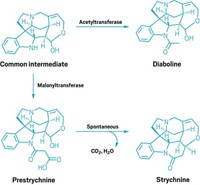Advertisement
Grab your lab coat. Let's get started
Welcome!
Welcome!
Create an account below to get 6 C&EN articles per month, receive newsletters and more - all free.
It seems this is your first time logging in online. Please enter the following information to continue.
As an ACS member you automatically get access to this site. All we need is few more details to create your reading experience.
Not you? Sign in with a different account.
Not you? Sign in with a different account.
ERROR 1
ERROR 1
ERROR 2
ERROR 2
ERROR 2
ERROR 2
ERROR 2
Password and Confirm password must match.
If you have an ACS member number, please enter it here so we can link this account to your membership. (optional)
ERROR 2
ACS values your privacy. By submitting your information, you are gaining access to C&EN and subscribing to our weekly newsletter. We use the information you provide to make your reading experience better, and we will never sell your data to third party members.
Synthesis
Marine microbial dehalogenase removes unwanted bromine
Extra bromine needs to go before final coupling reaction in the biosynthesis of pentabromopseudilin
by Celia Henry Arnaud
October 17, 2016
| A version of this story appeared in
Volume 94, Issue 41
Although the marine natural product pentabromopseudilin was first characterized 50 years ago, its biosynthesis is still not completely understood. Researchers at the University of California, San Diego, have now determined that, in addition to enzymes for adding bromines to the molecule, the biosynthetic pathway for pentabromopseudilin also includes an enzyme for removing bromine (J. Am. Chem. Soc. 2016, DOI: 10.1021/jacs.6b08512). A set of enzymes in the pathway catalyzes the synthesis of the needed precursors. But one of those precursors has one too many bromines. The enzymes make 2,3,4,5-tetrabromopyrrole when what’s really needed is 2,3,4-tribromopyrrole. Bradley S. Moore and coworkers have identified Bmp8 as the enzyme responsible for the required dehalogenation. After Bmp8 removes the unwanted bromine via a redox thiol mechanism involving a specific cysteine residue, another enzyme couples the tribromopyrrole to 2,4-dibromophenol to form pentabromopseudilin. The enzymatic dehalogenation of man-made persistent organic pollutants is well-known, but to the best of the researchers’ knowledge, Bmp8 is the first example of a marine microbial dehalogenase that’s involved in the biosynthesis of a halogenated natural product.






Join the conversation
Contact the reporter
Submit a Letter to the Editor for publication
Engage with us on Twitter